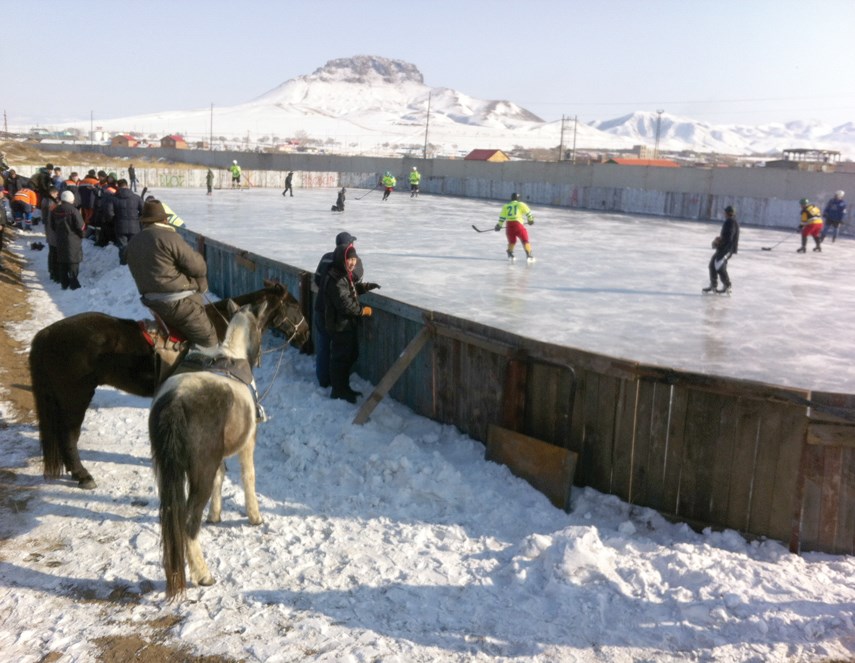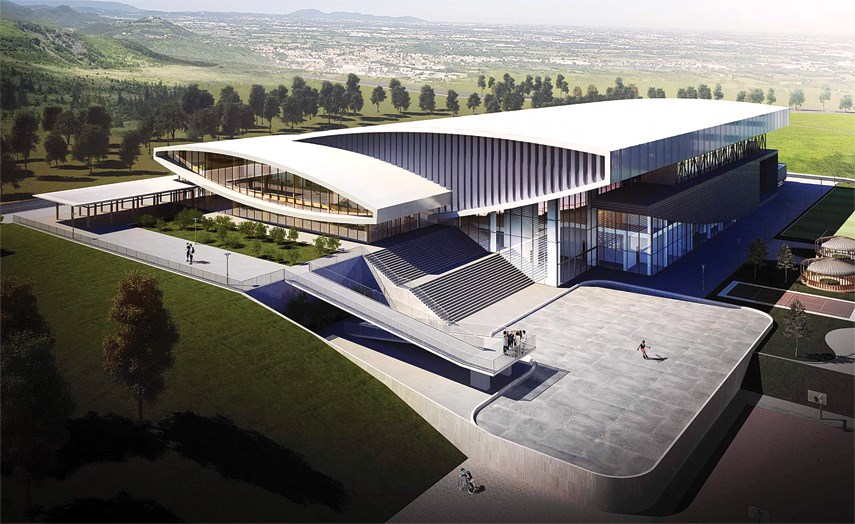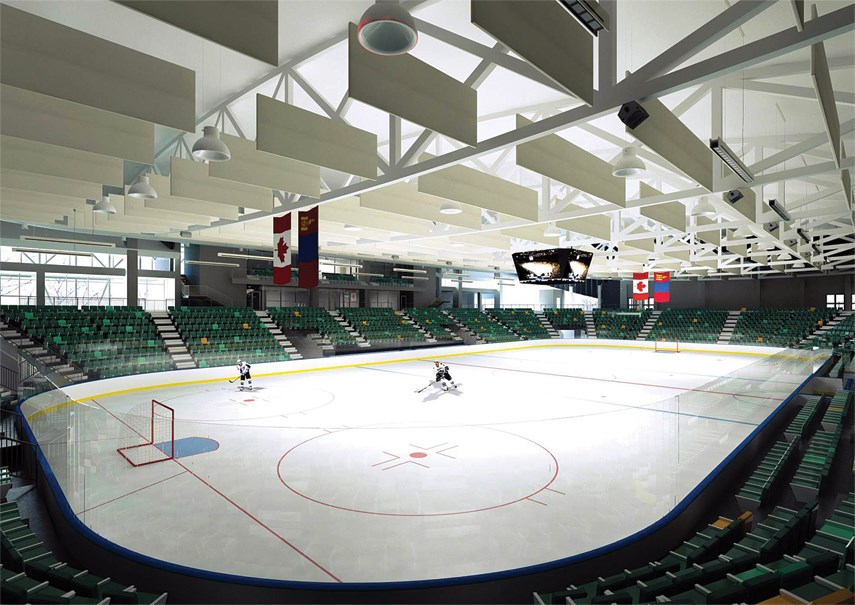All the elements are there: A climate akin to northern Saskatchewan, a tough and sports-loving people, and a love for the game. But if Mongolia ever wants to be a force in the hockey world, they’re going to have to come in from the cold.
Since 1999, the country has had membership in the International Ice Hockey Federation, and although they are not currently ranked in the top 50 teams, they did this year win their first ever Asian tournament. It was an impressive feat considering they’re the only team that doesn’t have the advantages that come with an indoor arena.
“They’re hardcore hockey fans over there,” said North Vancouver architect Mark Hentze. “But they play outdoors, which is the crazy thing.”
Hentze is now one of the principal architects working on final designs for the Steppe Arena – the country’s first indoor rink where the national team will play.
When Canadian consulate staff in Ulan Bator heard about the plans, they recommended the designers search out some Canadian expertise. The project leaders contacted Victoria-based VDA Architecture’s Kevin Klippenstein who reached out to Hentze’s firm HDR CEI to collaborate on the project that is now bringing together design, sport and national pride in the remote capital.
Old-time hockey
Mongolia’s love of the game stems from Cold War geopolitics. For much of its modern history, the country was a puppet state of the Soviet Union, relying on the USSR for trade and development.
In the early ’70s, young Mongolians idolized the Russian national team and their stars from the Summit Series with Canada – Alexander Yakushev, Valeri Kharlamov and Vladislav Tretiak.
Hentze was watching with his Grade 1 classmates when Paul Henderson scored his famous goal in ’72, but his clients on the Steppe Arena project were cheering “ferociously” for the Russian national team.
But, in speaking with his clients, Hentze learned there is something a little more behind the hockey love, tied to the rugged way of life on the steppe and perhaps an ancestry that used force to create the largest land empire in history.
“They said, ‘You know, it’s Mongolia. We love violent sports. That’s why we like hockey,’” Hentze said, noting Mongolia also has a reputation for producing competitive athletes in wrestling (both Greco-Roman and Sumo) and weightlifting.
When the Soviet Empire collapsed and the Russians pulled out in 1989, the love of hockey stayed.
One person who has witnessed Mongolia’s enduring love for the game is North Vancouver freelance videographer Pat Bell. Bell spent nine days in the winter of 2015 trudging around the country shooting a documentary about the sport. The film Rinks of Hope: Project Mongolia, followed brothers and former pros Boe and Nate Leslie who volunteered to bring their player development program to the country’s youth.
“Their winter has the most beautiful blue sky you’ve ever seen, but every rink is outdoors, including the one downtown,” Bell said. “Their passion for hockey is just incredible.”

As you might expect, the game lacks a lot of the polish Canadians have come to expect. Broken sticks are scabbed back together and when one shift on the ice ends, kids must share skates with the next line going on.
“We were off in the region where the hockey boards were literally pieces of fencing. There are no gates. At the end of the game, you take a warm bucket of water and rag and you wipe the ice down,” Bell said. “They ride their horses to the game in their hockey gear.”
On the ice though, they play an intense, old time hockey kind of game.
“They want to hit,” Bell said.
Hentze’s expertise doesn’t just stem from his training in architecture. As a younger man, he played high-level hockey. In 1987-88, he scored four goals and three assists and racked up 54 penalty minutes playing 24 games for the UBC Thunderbirds. And he spent two years as a pro for HC Zweibrucken in Germany’s 2nd Bundesliga.
It was Hentze’s experience playing in Europe that, in part, pushed him into architecture as a profession.
“I’m playing in all these arenas all over Germany and Czechoslovakia and Italy and Switzerland and places that were doing things that were not conventional in Canada,” he said.
Let there be light
Hockey may be religion in Canada, but there is a lot we could learn from others when it comes to the design of our temples, Hentze said.
“There’s a little bit of a mindset about arenas in Canada that they need to be these black boxes where people play hockey and that’s the only thing they do,” he said. “One of the things I’m looking for in arena design is to get natural light into the arena. It’s not as common in Canada as it is in other places in the world.”

Hentze has designed a number of public arenas and community centres around the country. The Mongolian project leads sent two delegations to tour’s B.C.’s facilities to get an idea of what was possible. One of the stops was the new Delbrook Rec Centre, which Hentze and his firm did the award-winning designs for.
“They were really quite taken by the transparency of the design at Delbrook with all the glass and the ability to see inside and outside the building – that indoor-outdoor connectivity,” he said. “That was very gratifying because the District of North Vancouver, and the rec commission and we as architects all had this mutual goal – transparency.”
Hentze applied the same thinking to the Ulan Bator rink, using glass strategically placed along the entire north side of the building.
“On the south side, you’ve got this nasty, glaring hot sun that sweeps across the Mongolian Steppes every summer and puts the temperature into the high 30s. We didn’t want that solar gain beating up our building and wreaking havoc with ice-making,” he said.
The building site is less than three kilometres from Chinggis Khaan International Airport (yes, it’s named after the man better known to Westerners as Genghis Khan), which the design draws inspiration from. The roof reflects the airfoil shape of a plane’s wing. It also slants to the south to maximize exposure for the solar heating cells that line the roof.
And much like Delbrook, the building uses the natural sloping topography to keep much of the structure underground.
While the West Coast style’s hallmarks of glass and blending in are clearly evident in the renderings, no one on the Mongolian design team wanted to draw on their own vernacular yurts and temples or Russian imperial influences.
“As we’ve worked together to develop this aesthetic, what’s really important to them is they don’t want something that is kitschy and has historical references,” Hentze said. “They want to use this building to be recognized as a forward-thinking, modern country.”

When complete, it should be big enough for 2,600 screaming fans in bowl seating. And the facility will be adaptable for other sports, music and cultural events something akin to the Poirier Sports & Leisure Centre in Coquitlam, another of Hentze’s projects.
The firms have now nearly completed the design schematics for the Steppe Arena. The next step is one Hentze is all too familiar with.
“It’s interesting. Here we are in an exotic location and they have to deal with all the same funding issues that we do in Canada for this kind of project,” he said, noting it has federal funding but the developers are also seeking private contributions as well.
Next year’s prospects
If the arena achieves what the Mongolian national team and Hentze are hoping for, it will mean going from bush league to big league.
“This is why in so many ways, this project is such an important thing to them. It will actually give them the opportunity to take their hockey programs to a little bit more of a serious and organized level where they’re not so weather dependent,” he said.
Bell has already seen a glimmer of what the future of Mongolian hockey might look like. During filming of “hockey night in Mongolia” for the documentary, it was -37 C and pitch dark out when they arrived at 10 p.m. for a coaching session.
“All of a sudden 80 kids appear and they’re ready to play, most with no gloves and no hats,” Bell said. “If they learn the skills of the game, it will be incredible. Absolutely incredible … Talk about tough as nails.”
If all goes well, construction on the arena is set to begin in the spring of 2019 – just as soon as this season’s rinks have melted back into the steppe.



